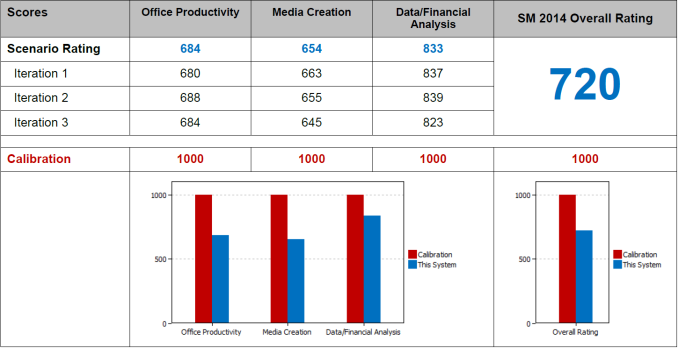The Intel Compute Stick (Core m3-6Y30) Review
by Ganesh T S on June 27, 2016 8:00 AM EST- Posted in
- Systems
- Intel
- Core M
- Skylake
- HDMI Stick
- Compute Stick
Performance Metrics - I
The Intel Core m3-6Y30 Compute Stick was evaluated using our standard test suite for low power desktops / industrial PCs. Not all benchmarks were processed on all the machines due to updates in our testing procedures. Therefore, the list of PCs in each graph might not be the same. In the first section, we will be looking at SYSmark 2014, as well as some of the Futuremark benchmarks.
BAPCo SYSmark 2014
BAPCo's SYSmark 2014 is an application-based benchmark that uses real-world applications to replay usage patterns of business users in the areas of office productivity, media creation and data/financial analysis. Scores are meant to be compared against a reference desktop (HP ProDesk 600 G1 with a Core i3-4130, 4GB RAM and a 500GB hard drive) that scores 1000 in each of the scenarios. A score of, say, 2000, would imply that the system under test is twice as fast as the reference system.
Since SYSmark 2014 was not processed on any of of the PCs in our comparison list, we present the scores obtained in the three iterations of the benchmark above. Obviously, a 7.5W TDP Skylake Core M is no match for a 54W Haswell Core i3. However, it still manages to delivery more than 70% of its performance for business workloads.
Futuremark PCMark 8
PCMark 8 provides various usage scenarios (home, creative and work) and offers ways to benchmark both baseline (CPU-only) as well as OpenCL accelerated (CPU + GPU) performance. We benchmarked select PCs for the OpenCL accelerated performance in all three usage scenarios. These scores are heavily influenced by the CPU in the system. Most of the PCs in our comparison list are equipped with anaemic Atom processors, and the Core m3-6Y30 manages to easily better them in performance despite the form factor limitation.



Miscellaneous Futuremark Benchmarks





3D Rendering - CINEBENCH R15
We have moved on from R11.5 to R15 for 3D rendering evaluation. CINEBENCH R15 provides three benchmark modes - OpenGL, single threaded and multi-threaded. Evaluation of select PCs in all three modes provided us the following results.














105 Comments
View All Comments
jaydee - Monday, June 27, 2016 - link
Until this thing can get power over HDMI, I just can't see these going far.nathanddrews - Monday, June 27, 2016 - link
HDMI doesn't offer the power required to charge a phone, let alone peak usage from a Chromecast. I think you meant MHL/SuperMHL?lilmoe - Monday, June 27, 2016 - link
My next TV will have USB-C ports, that's for sure. Fully featured ones at that.jaydee - Monday, June 27, 2016 - link
Just in general, until this type of device can drop the power adapter, I don't see how it's form-factor (sticking out of a TV) is that much of an advantage over something that sits on the desk. Whether it's HDMI or some other standard.Murloc - Monday, June 27, 2016 - link
also sticking out of the TV poses various issues.I think it's a dumb format, if you have a power brick and cable laying around anyway, it doesn't make a difference to have it attached to the TV or lying on the floor.
mkozakewich - Monday, June 27, 2016 - link
They'll be USB C with DisplayPort passed through. Either the TV will act as a USB hub, or you could connect a USB hub between the dongle and the TV to get access to ports.The_Assimilator - Monday, June 27, 2016 - link
"Small and power-efficient computers in the form of NUCs and Compute Sticks have emerged as bright spots in the PC market over the last few years."Then Intel canned Atom and that bright spot went away. The Atom compute sticks were already on the edge of affordability, these Core M models are more than twice the price and thus make exactly zero financial sense unless you absolutely need x86.
RIP compute stick, we hardly knew you.
Gunbuster - Monday, June 27, 2016 - link
Even the best atom was at the edge of "oh I think this performance might be okay this time around, and then you load it up in real world multi app workload and it slows to a crawl"If they moved Core M pricing into the world of sanity everything would be perfect.
beginner99 - Monday, June 27, 2016 - link
Yeah but that was probably due to only 2GB of ram and slow storage. 2GB is just not enough.Gunbuster - Monday, June 27, 2016 - link
I've got a Asus Atom powered T100HA with 4GB. Doesn't make a difference. Once you have a real workload like OneDrive, Dropbox, Skype, OneNote, Chrome, Outlook running is starts to lag. It's not pegging out the RAM or Storage, It just struggles that little bit in everything and it gets really frustrating.